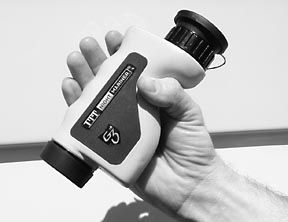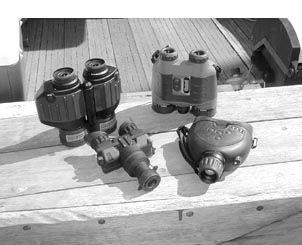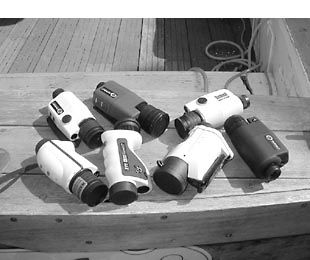This is our third report on the growing assortment of night scopes marketed for the serious boater, and this is the third time the ITT Night Vision Generation 3 products get our Best-In-Class vote. At the same time, Russian factories are turning out decent, lower-cost Gen 2 scopes for the US market. Night Owl’s Explorer G2 provides an excellent balance of performance vs. cost. Newcon’s military-type Gen 2 goggles are great performers and a good choice for readers operating in countries where Gen 3 scopes are not available due to US export restrictions. Night Owl and Bushnell also offer relatively inexpensive Gen 1 night vision aids that our reviewers liked.

Evaluation Procedures
The numbers of night vision products on the market seem to proliferate exponentially, so we chose to limit our evaluation to mainstream providers that clearly target recreational boaters—power and sail. As usual, we combed the major marine discount catalogs and Internet sites for products.
The manufacturers and distributors that clearly met our criteria were Bushnell, ITT Night Vision, Newcon Optik, and Night Owl. In the end, we narrowed our focus to 11 scopes, four of them binocular-style instruments and the rest monocular devices. The group included representatives of the three current night vision technologies (generations)— Gen 1, Gen 2 and Gen 3.
It’s certainly possible to make objective comparisons of night vision scopes using specially designed test rigs, but the $100,000 price tag for this test equipment persuaded us to take a more subjective approach. We believe our low-tech human eyeball technique generated useful results.
We drafted volunteers from an area maritime search-and-rescue unit, the detective division of a medium-size police department, a fire/rescue team, and an inland lake constabulary, and asked each tester to try out various scopes on and around the water. The idea was to involve experienced folks who often find themselves attempting to observe things—all sorts of things—outdoors at night.
We asked each tester to evaluate three parameters—ergonomics, image quality without supplemental infrared (IR) illumination, and image quality with supplemental IR illumination.
Through March and early April we tried the scopes in as many ambient lighting conditions as possible —moonlight, starlight, high overcast, and low overcast. We also attempted to use the scopes in rain, snow, and fog, and along urban shorelines as well as on back-country lakes and woods.
Picking a Generation
Night vision scopes on the market today represent three technologies or generations—Gen 1, Gen 2 and Gen 3 —each respectively more capable and more expensive. As a rule of thumb, Gen 1 scopes carry street prices from $200 to $500; Gen 2 scopes come in at around $1,000 to $1,800, and Gen 3 scopes show at $2,000 or more. There’s an intermediate level that can be called Gen2+, which means that the units have some enhanced resolution, but are not as advanced as the Gen 3s.
Before studying further variations, let’s look at night vision technology itself, which is now over 40 years old. The earliest Gen 0 and Gen 1 units (“starlight scopes”) were used in the 1960s by US forces in Vietnam. The Cold War funded development in the US and Russia of more advanced Gen 2 night scopes in the 1970s. Then, in the 1980s, the Gen 3 scopes appeared for military users and, ultimately, for civilian users. Gen 3 devices are the most powerful available today on the civilian market. (You can bet there are Gen 4 scopes in use by the military today, but we’ll have to wait a few years for them to appear in the civilian marketplace.)
All generations of night scopes employ a three-step process to help us see stuff that would otherwise go bump in the night. First, they gather light energy (photons) in the front end and convert the photons to an electron stream. Second, they amplify or intensify the electron stream. Third, they use the intensified electron stream to paint an image on a viewable screen (much like a TV), thus converting the electrical energy back to light energy. The scope’s ocular (eyepiece) enables the user to focus on the displayed amplified image.
Gen 1 scopes accomplish the intensification task by speeding up the electrons and increasing the energy with which they strike the image plate. While Gen 1 scopes provide significant light amplification, their images suffer from some amount of fish-eye or barrel distortion. It is reported that the only new Gen 1 electronics are manufactured by a single Russian factory, so the differences in image quality among these scopes when they get to the market depends primarily on the optics of the system. For best quality in Gen 1 (as well as other generations) look for multiple element glass lenses. As is the case with camera lenses, the smaller the F-number, the better.
Gen 2 and Gen 3 scopes employ microchannel plates that add electrons to the stream in appropriate proportions. The Gen 3 system further enhances light amplification efficiency by coating the photocathode (the device that converts light energy to electrical energy) with gallium arsenide. For comparison purposes, if you assume that Gen 1 electronics amplify light about 1,000 times, then Gen 2 and 3 scope circuitry amplifies light 20,000 to 30,000 times. But, be careful with the amplification numbers cited by the marketers. In the real world, what you see is total system amplification, not just the amplification of the intensifier circuitry. Total system amplification is affected by optical losses, power supply inefficiencies, and other factors. That’s why we don’t quote amplification numbers in this article.
In a perfect world of unlimited boating budgets, you’d probably opt for a Gen 3 scope—all of our testers did. They’re mighty expensive, though, and we don’t think you lose much in terms of practical on-water viewing capability by going with a Gen 2 device.
Gen 1 devices are significantly less capable than the two more modern technologies, but they’re certainly better than nothing when you’re probing the darkness for a bobbing head or a buoy that has shed its reflective material.
Night Vision in the Real World
It’s important to understand that all night vision scopes need some light to work. The Gen 3 scopes are quite happy with starlight. The Gen 2 lights work best with moonlight. The Gen 1 devices must have additional IR illumination, typically built into the scope. (Of course, Gen 2 and Gen 3 systems can be helped out by additional IR illumination up to a point. Too much ambient light, though, is as bad as too little.)

For best viewing through any generation scope, the object should be back-lighted. For example, as we left Norwalk Harbor (CT) on a scope test we picked out unlighted buoys and head-sized unlighted floating objects quickly using all three generations of scopes. Coming back, however, the same objects were almost impossible to see against the background lighting of the shore communities. This is a situation in which too much light can be problematic.
On the other hand, we could pick up lighted buoys and identify their flashing characteristics at ranges far beyond the Light List specifications. Keep in mind, the view through any night vision scope is monochromatic green, so you can’t differentiate light colors.
Any atmospheric phenomenon that disperses or scatters light reduces the utility of the night vision scope. (This is the same situation you experience when you switch on a spotlight in fog. Light is scattered, reducing forward visibility.)
Interpreting what you’re seeing through the scope takes a bit of practice, too. Sometimes the contrast can fool you. For example, a shiny, dark object may appear brighter than a light-colored dull object. Remember, it’s the amount of light that an object reflects back to the scope that determines how the object will appear to the viewer.
We came up with all sorts of uses for night vision scopes in the marine environment. For example, the yard boss at Rex Marine Center used them for checking boats on the moorings; the Candlewood Lake Constable saw their value for peering into coves and gunkholes frequented by fishermen without having to physically enter each area; the search-and-rescue people were interested in the way the scopes could enable them to expand track spacing in grid searches for persons in the water (simulated). The law enforcement types are already familiar with the scopes for use in harbor patrols and other activities. The fishermen liked the scopes for picking their way through the unlighted rocks in the Norwalk archipelago.
Our evaluators were encouraged not to drop these items overboard, and, in fact, to please take care of them, so we cannot verify manufacturers’ claims of water resistance, waterproofness, or buoyancy. The data in the the table above are manufacturers’ claims.
Our evaluators debated the issue of monocular vs. binocular. We reached no conclusions on that score, but here are the facts:
The bright image produced by these scopes will wreck any night accommodation your eye(s) make. And, as you know, it takes about 20 minutes to reacquire night vision once you’ve lost it. So, some testers suggested that the monoculars were better because you “only destroy the night vision in one eye.” Admittedly, you do end up somewhat dazzled when one eye is accommodated to darkness and the other is not. The binocular advocates point out that it is difficult to keep one eye closed for any length of time and you can become fatigued quickly using a monocular. The binoculars do not provide the user with depth unless each ocular has its own light intensifier. The monoculars are, logically enough, less expensive, but other than that, the choice seemed to boil down to personal preference.
The Products
As was the case in our previous reports, first place goes to the two Gen 3 ITT Night Vision products we evaluated. These devices with their excellent, bright, high-resolution images and great ergonomics are in a class by themselves in the consumer market—a fact that even the competitors grudgingly admit. But they are pricey.
The best all-around product for serious marine use in our opinion is the ITT Night Vision Night Mariner 160. With a street price about $1,640, this Gen 3 monocular was the favorite of all our testers not only for its bright, crisp images but also for its clever grip-enhancing shape and non-skid rubber side panels. The grip works well for both right- and left-handed users. The 160 won’t slip out of cold wet fingers, nor will it slide around on horizontal surfaces. It’s waterproof and floats. It operates on two AAA batteries, and is relatively lightweight at just over a pound. Optional accessories for the NM 160 include a magnetic compass adapter kit, an IR illuminator kit, and various magnifier lenses including a 2.2x magnifier lens and a 3x military lens.
Coming in a close second for serious marine use is ITT’s Night Mariner 222, binocular system using a single light intensifier tube and objective lens. The NM222 binocular was the only scope we tested that was equipped with an adjustable gain (brightness) control—a desirable feature, we thought, on any Gen 3 device. (Gain controls are not needed in Gen 1 and 2 scopes where you want every bit of amplification you can get.) The NM222 also has a built-in IR illuminator, special eyecups for eyeglasses wearers, and a head mount. It takes a bit of fumbling to get the head mount adjusted, but the 20-oz NM222 with its padded eyepiece is fairly comfortable for long viewing sessions. The NM 222 can be equipped with an optional compass adaptor and various lenses including a 60- to 300mm zoom. All ITT products are built in the US.

Another high-end device our testers liked was Newcon Optik’s NVS-7 goggles. This Gen 2+ scope has a single light intensifier with a binocular view system. It has great ergonomics—easy to hold, quick to focus, and its military shape assures a good grip. It’s waterproof too. Most important, its high-resolution Gen 2 electronics provide an excellent, high-resolution, long-range view. (Newcon said the Royal Navy has ordered the NVS-7 for its bridge officers after comparative tests.)
The scope is equipped with a head-mount harness. A 4x military lens is available as an option. A supplemental IR light is provided, more for map reading than for long-distance illumination. Street price is about $2,100. The NVS-7 is made in Russia.
In the Best-Bang-For-the-Buck category, we liked Night Owl’s Explorer G2 (NOXG2), a Gen 2+ monocular with a street price just under a thousand dollars, plenty of standard features, and the optics and electronics to produce first-class images. While not as grip-friendly as the ITT NM160, the Night Owl G2 ergonomics were rated “good” by our testers. The body is rubberized and the power and IR buttons fall conveniently under the (right-hand) user’s first and second fingers. It can’t be set up for a left-handed user. The image quality is good, with sharp resolution at medium distances and little edge distortion. The mating of the IR light coverage area and the scope’s field of view is best in class. The G2 (and most other Night Owl scopes) accept T-mount camera and video adaptors. It’s waterproof and floats.
For the truly budget conscious, we liked Bushnell’s model 2642W and the identical (so far as we can tell) Night Owl NONO3Y. These Russian-built Gen 1 monoculars provide a comfortable although potentially slippery grip, and handy LED indicators for power and IR illuminator status. Their image quality is fair within a hundred yards or so and really quite good with the help of the built-in illuminator light. If your requirement is to read the occasional buoy or to see what’s going on in a darkened marina, these scopes are really quite adequate. A search for street prices turned up $300 for the Bushnell version and just over $200 for the Night Owl offering.
Night Owl’s Explorer Marine Pro is a reasonable low-budget choice in the Gen 1 category. It has a hefty 4x lens, and is packaged in a rubberized body similar to the one used by the company’s Gen 2 device.
The Bushnell 26-0400 is an interesting device—a true binocular with two light tubes, one for each eye. The dual optical channels provide some degree of depth perception and could be of advantage to folks who have a problem with keeping one eye closed when using a scope. The image brightness and resolution is about the same as the Gen 1 monoculars. This binocular comes with its own sunglasses (inserted in the lens covers), so the device can be used in daylight, although the image is monochromatic green. Logically, the street price is about twice that of a Gen 1 monocular.
Newcon’s MB-3 Gen 1 monocular is inexpensive ($275) and provides only fair and short-range performance. However, it is waterproof and floats, and is well designed for gripping. It will serve well in situations where the viewer is interested in relatively large objects at close range.
Newcon’s Phantom 150, a Gen 2 monocular with a street price of $1,100 was promising, yet disappointing. Its Gen 2 image was nowhere near as sharp as that produced by the Newcon NVS-7, and the IR illuminator, on the unit we tested, wiped out the image altogether. The manufacturer told us it might be a problem with the automatic gain circuitry.
Exploration of the accompanying tables will place the other products appropriately.
As the price comes down on night vision scopes, these devices are moving out of the luxury class and into spending range for the rank and file. Sailors who spend much time in dark waters, especially waters with obstructions and hazards, are likely to find this technology comforting.
We still favor the ITT units, but there are different prices and performance needs for everyone. Try to shop for a scope with a dealer who offers a good returns policy.
Also With This Article
Click here to view “Value Guide: Night Vision.”
Contacts– Bushnell Corp., 9200 Cody Overland Park, KS 66214, 800/423-3537; www.bushnell.com. ITT Industries Night Vision, 7635 Plantation Rd.; Roanoke VA 24019, 800/448-8678; www.ittnv.com. Newcon Optiks, 1183 Finch Avenue West, suite 302, Toronto, Ontario, M3J 2G2, Canada; 416/663 6963; www.newcon-optik.com. Night Owl Optics 307 7th Ave., New York, NY 10001; 212/229-0297; www.nightowloptics.com.
































